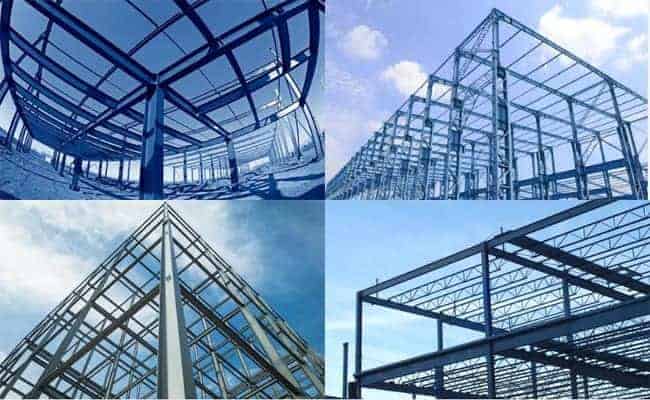Application of Steel Structure in Civil Engineering
Reinforced concrete and structural steel are the most commonly used materials in civil engineering structures. Civil engineering construction should start from the structural characteristics and comprehensively examine the cost and effectiveness of construction. Next, this article focuses on the application of steel structures in civil engineering and briefly describes the key points of steel structure construction.
Application of Steel Structure in Civil Engineering
Application of steel structure in civil engineering, large space span steel structure, high-rise heavy steel structure, light steel structure building. Among them, large-span steel structure buildings often appear in the construction of airports and gymnasiums. The high-rise heavy steel is connected by section steel and steel plate and then welded. Light steel uses thin steel plate cold-rolled section steel to form a skeleton structure used in factories, warehouses, and other buildings.
Steel is the most important and widely used structure in civil engineering construction. The construction of the engineering structure is completed through the combination and utilization of steel materials. During the structural construction of the building, the hoisting and preparation of the steel structure deserves special attention. The hardness, unique volume, and steel weight make combining and hoisting steel more challenging. Generally speaking, the site must conduct road construction and road cleaning before hoisting. At the same time, carefully check the equipment for hoisting and transportation, such as cranes and trucks, to ensure the safety of construction personnel.
Advantages of Steel Structure Application in Civil Engineering
Steel structures are more widely used in civil engineering construction. With the increase of new technologies for steel production, the application of steel structures has become more extensive.
1. High strength.
The strength of the material determines the capacity of steel structural members. Generally, standards are used to assess performance, and building structures meet CSA standards, ASTM standard A992/A992M, and other standards. The yield strength ranges from about 270 to 700Mpa, and the design of specific building steel structures is essential for selecting steel types and strengths. Using steel structures can reduce material consumption, structural weight, supporting components, and the cost of building structures.
2. Strong rigidity.
The various parameters of vibration and deformation are composed of component stiffness and determined by the stiffness of the structural system. Structural system stiffness includes members and other connections. Simply put, its stiffness is determined by the material’s section properties and modulus of elasticity. In the general sense, the density and compressive strength of concrete is within 20-40Gpa, and the modulus of elasticity of concrete is within 21-29GPa; the modulus of elasticity of high-strength concrete is between 41-46GPa, and the steel structure has a significant advantage in rigidity.
3. Extensibility.
Ductility refers to the ability of a material to stretch without breaking. Ductility is an essential parameter in structural design. The material flexibility is not always transformed into the intrinsic elasticity of the building structure, and the design strategy adopts the stagnation mechanism. Usually, the design has the flexibility to have sufficient cross-section, elasticity, and structural ductility. The ductility value is to match the variable ductility level, member flexibility, and structural ductility. Although the flexibility of the steel structure is very high, the curvature flexibility of the member is usually insufficient because the force of the structural flexural member is not very stable.
4. High toughness.
Toughness is an index of material fracture energy absorption and deformation ability. The role of toughness is to resist notch instability crack growth. It is the primary characteristic of steel structures to withstand many industrial deformations. Steel members’ toughness reduces crack generation during bending, shearing, drilling, etc. The fracture toughness of steel structures is more important for buildings subjected to impact loads. Temperature conditions are an essential factor affecting the toughness of steel structures, and the temperature decreases.
5. Wholeness.
As mentioned above, steel structure is superior to reinforced concrete, can construct exotic architectural forms, and can provide design flexibility and maximize space utilization. The steel structure uses hollow steel brackets, which can provide channels for pipelines and power supply lines. Steel frames are used to add stories. During construction, fewer personnel are required; the quality of steel structure installation and fabrication should be reliable and straightforward. When modified, steel structures cost less. Additional support system steel structures can speed up the construction progress.
Disadvantages of steel structure application in civil engineering
Poor fire resistance of steel structures brings building fire prevention problems.
Steel is not an explosive substance but has a specific heat resistance. Still, when the temperature reaches a certain height, the bearing capacity of steel will also change significantly. When the temperature exceeds 200 degrees Celsius, the strength of the steel will decrease with the temperature increase. After the temperature exceeds 600 degrees Celsius, the steel will lose its original bearing capacity. In general buildings, fire prevention work is still a relatively big problem. After a building catches fire, when the temperature rises, the bearing capacity and stability of the steel will continue to decline, which may eventually lead to a complete collapse of the building.
In short, as the country promotes energy conservation and environmental protection, steel structure buildings will increase significantly. China’s steel prices are low, labor costs are standard, and steel structures are highly quality and competitive. Therefore, the application of steel structures in civil engineering has more room for development.
The post Application of Steel Structure in Civil Engineering appeared first on Havit Steel in design and fabricated Metal Buildings in China.

